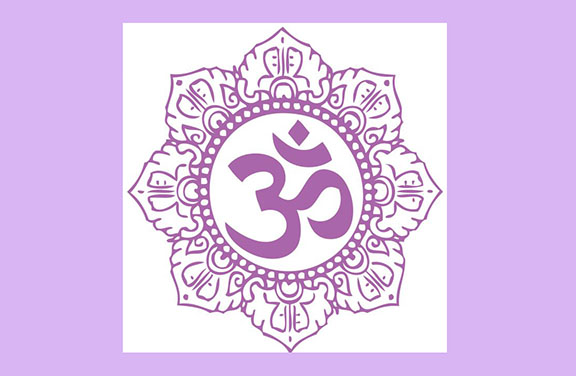 Rev. Jaganath, Integral Yoga Minister and Raja Yoga master teacher, has spent a lifetime delving into the deepest layers of meaning in Patanjali’s words within the Yoga Sutras. Our series continues with the 27th and 28th sutras of Chapter 1 in which Patanjali now talks about Ishvara as the “mystic sound OM.” In these two sutras, Patanjali reveals an important practice that will lead the yogi toward samadhi: Japa Yoga.
Rev. Jaganath, Integral Yoga Minister and Raja Yoga master teacher, has spent a lifetime delving into the deepest layers of meaning in Patanjali’s words within the Yoga Sutras. Our series continues with the 27th and 28th sutras of Chapter 1 in which Patanjali now talks about Ishvara as the “mystic sound OM.” In these two sutras, Patanjali reveals an important practice that will lead the yogi toward samadhi: Japa Yoga.
Sutra 1.27: tasya vācakaḥ praṇavaḥ
The word expressive of Ishvara is the mystic sound OM [OM is God’s name as well as form.] (Swami Satchidananda translation). Ishvara expresses as the primordial sound OM, also known as pranava (Rev. Jaganath translation).
tasya = that – (refers to Ishvara)
vācakaḥ = expresses; speaking, saying, telling anything, speaking of, treating of, declaring, expressive of, expressing, signifying, expressed by words, a significant sound or word, a messenger
from vac = to speak
praṇavaḥ = OM
from pra = to give, offer, bestow, before, forward + nava, from nu = sound, shout, exult
from av = to support or protect
OM is a word of solemn affirmation and respectful agreement, sometimes translated as yes, verily, or so be it. In this sense, it can be compared with Amen. It is placed at the beginning of most Hindu works. Traditionally, it may be quietly repeated at the beginning and end of a reading of the Vedas or to begin any prayer. OM is also used as part of an auspicious salutation (Hail!).
In the Upanishads, OM appears as a powerful mantra that is the object of profound meditation. OM represents the entire Veda and since the Veda is considered one with Brahman, OM is regarded as the equivalent of Brahman.
OM is comprised of three letters in Sanskrit: a, u, m. In later Hinduism, it embodies the powers of the Hindu triad of gods, representing the union of the three gods, a = Brahma, the creator, u = Vishnu, the sustainer and m = Siva, the dissolver.
Sutra 1.28: taj japaḥ tad artha-bhāvanam
To repeat it with reflection upon its meaning is an aid (to samadhi) (Swami Satchidananda translation). Repeat it with focus, devotion, and right understanding and the purpose of this practice is revealed (Rev. Jaganath translation).
OM stands for the Supreme Reality. It is a symbol for what was, what is, and what will be. OM represents also what lies beyond past, present and future.
~Mandukya Upanishad
taj = that (refers to OM)
japa = to repeat; muttering, whispering, to repeat in a murmuring tone, passages from scriptures, mantras, or names of a deity
The word jap is quite common in the Brahmanas. It refers to the priest’s low muttering of mantras and sacred texts during ritual sacrifice. Japa is considered a form of tapas in the Dharma Sutras. The Bhagavad Gita lists japa as the greatest sacrifice.
Japa, then, is the interiorization of ritual sacrifice, a significant development toward the mystical or contemplative practices found in many faith traditions. Tradition teaches that silent japa is one thousand times more powerful than outward sacrifice.
Svadhaya (study) and japa (repetition) are closely related. This emphasizes that study is more than collecting information. It is about the transformation of the individual. Old habits have to be transcended and new ones created, hence, the importance of repetition.
tat = (refers to the purpose of the practice) that
artha = purpose; meaning, aim, cause, motive, reason, advantage, use, utility, wish, relating to a thing or object, material, means of life, true sense, occurrence (event), profit, object of desire, advantage, utility, and reason
Artha is difficult to reduce to a single English word. Its meanings vary widely and sometimes seem contradictory. Artha may best be described as the pursuit of any activity and the use of any means to create a peaceful, joyous life, foster harmony, without causing harm to anyone.
It is also described as the attitude and capacity necessary to make a living, remain alive, and thrive. Artha includes attaining prosperity, security, and health—the necessities of life.
Of particular interest in the context of the Sutras, is artha as true sense, occurrence (event), profit, object of desire, advantage, utility, and reason. The practice of japa reveals the true nature of OM, its spiritual utility, its benefits, and cultivates realization of the object of desire: realizing our connection with Ishvara and attaining the wisdom pointed to by Vedic scripture.
Some ancient Indian texts suggest that artha is anything that enables the satisfaction of desires, protecting what is already acquired, and increasing what is valuable. At the same time, it is required that, in acquiring possessions,none of the principles of dharma should be violated.
bhāvanam = focus, devotion, right understanding
reflection, feeling of devotion, faith in, right conception or notion, thought, emotional intent, causing to be, manifesting, mind development, producing, displaying, promoting or affecting one’s welfare, mental discipline, imagining, fancying, teaching, forming in the mind, conception, apprehension, supposition, meditation, direct one’s thought to, (in logic) that cause of memory which arises from direct perception, furthering, nature, essence
from bhāv = becoming, being, existing, occurring, appearance, transition into, continuance, continuity of existence through successive births, state, condition, rank, state of being anything, true condition or state, truth, reality, manner of being, nature, temperament, character, manner of acting, conduct, behavior, any state of mind or body, way of thinking or feeling, sentiment, opinion, disposition, intention, passion, emotion, conjecture, supposition, meaning, love, affection, attachment, the seat of feelings, heart, soul, mind, any living creature, the world, universe, the Supreme Being, advice, instruction, contemplation, meditation.
from bhū = to become, exist, causing to be, affecting, producing, manifesting, displaying, contemplation, condition, inherent qualities of mind, feeling (in Bhakti Yoga) + ana = the act of doing and the vehicle for doing it.
Bhavana is the emotion with which the work is being done, the real motive with which the first move into the activity was made. Bhavana is the most basic factor of all activity.
~ Sri Santananda Saraswati
Bhav, bhava, and bhavana, all different forms of the root, bhu, occur seven times in the Sutras. As you can see above, the meanings of bhavana are vast and varied. That’s because, bhu— existence or becoming—encompasses the essential nature of life: being and becoming, consciousness and matter, thinking and feeling. Bhavana can refer to the act of contemplation as well as the “mental environment” in which thoughts appear.
When we come across this word in the Sutras, or in any Sanskrit text, it would be wise to pause and reflect on what the author might be trying to communicate. It’s not likely that any English word captures the richness of this family of definitions. Yogis can consider that bhavana carries the sense of being absorbed emotionally and mentally in a practice, a practice that is informed with the right knowledge of theory and its goal.
In Buddhism there are two types of bhavana: the development of tranquility and the development of clear perception. The first leads to the second; it refers to development of the mind. For the Jains, the word is used to mean to reject conceptualizations.
About the Author:
 Reverend Jaganath Carrera is and Integral Yoga Minister and the founder/spiritual head of Yoga Life Society. He is a direct disciple of world renowned Yoga master and leader in the interfaith movement, Sri Swami Satchidananda—the founder and spiritual guide of Satchidananda Ashram–Yogaville and Integral Yoga International. Rev. Jaganath has taught at universities, prisons, Yoga centers, and interfaith programs both in the USA and abroad. He was a principal instructor of both Hatha and Raja Yoga for the Integral Yoga Teacher Training Certification Programs for over twenty years and co-wrote the training manual used for that course. He established the Integral Yoga Ministry and developed the highly regarded Integral Yoga Meditation and Raja Yoga Teacher Training Certification programs. He served for eight years as chief administrator of Satchidananda Ashram–Yogaville and founded the Integral Yoga Institute of New Brunswick, NJ. He is also a spiritual advisor and visiting lecturer on Hinduism for the One Spirit Seminary in New York City. Reverend Jaganath is the author of Inside the Yoga Sutras: A Sourcebook for the Study and Practice of Patanjali’s Yoga Sutras, published by Integral Yoga Publications. His latest book, Patanjali’s Words, is a work-in-progress.
Reverend Jaganath Carrera is and Integral Yoga Minister and the founder/spiritual head of Yoga Life Society. He is a direct disciple of world renowned Yoga master and leader in the interfaith movement, Sri Swami Satchidananda—the founder and spiritual guide of Satchidananda Ashram–Yogaville and Integral Yoga International. Rev. Jaganath has taught at universities, prisons, Yoga centers, and interfaith programs both in the USA and abroad. He was a principal instructor of both Hatha and Raja Yoga for the Integral Yoga Teacher Training Certification Programs for over twenty years and co-wrote the training manual used for that course. He established the Integral Yoga Ministry and developed the highly regarded Integral Yoga Meditation and Raja Yoga Teacher Training Certification programs. He served for eight years as chief administrator of Satchidananda Ashram–Yogaville and founded the Integral Yoga Institute of New Brunswick, NJ. He is also a spiritual advisor and visiting lecturer on Hinduism for the One Spirit Seminary in New York City. Reverend Jaganath is the author of Inside the Yoga Sutras: A Sourcebook for the Study and Practice of Patanjali’s Yoga Sutras, published by Integral Yoga Publications. His latest book, Patanjali’s Words, is a work-in-progress.

